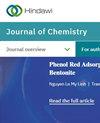硫血红蛋白检测的洞察力:紫外可见光谱与荧光光谱的相关性
IF 2.6
4区 化学
Q2 CHEMISTRY, MULTIDISCIPLINARY
引用次数: 0
摘要
药物和几种含硫化学物质诱导硫血红蛋白形成的机制尚未阐明。不过,哺乳动物组织和器官中产生硫化氢的酶表明,硫化血红蛋白和硫化肌红蛋白的形成机制比以前假设的更为复杂。这一过程涉及 H2S 在 O2 或 H2O2 的存在下与血红蛋白或肌红蛋白相互作用,分别生成硫血红蛋白或硫肌红蛋白。从结构上看,硫血红素产物发色团是一种共价血红素修饰。这种修饰涉及在碳原子中加入一个硫原子,在血红素吡咯 B 的 β-β 双键上形成一个硫碳环分子,硫高铁血红蛋白和硫高铁血红蛋白分别在 623 纳米和 618 纳米附近显示出特征光带。结果显示,在 420 纳米波长的索雷特激发下,623 纳米波长的硫高铁血红蛋白电子电荷转移转变与 460 纳米波长的发射波长之间存在线性关系。数据显示,氧-血红蛋白和元-血红蛋白没有这种线性关系。通过这种新方法,我们可以测量元红血红蛋白和氧合血红蛋白混合物中 0.02% 到 13.5% 的硫合血红蛋白。尽管还需要做更多的工作,但研究结果表明,同时监测 623 纳米波长的硫化血红蛋白电子跃迁和 460 纳米波长的发射波长以及 420 纳米波长的索雷特激发波长,是测定血液中硫化血红蛋白百分比的一种有效技术。所提供的数据和技术表明,荧光光谱与紫外-可见光谱联用为检测血液中的硫血红蛋白提供了一种快速、准确的方法,有助于诊断患者的硫血红蛋白血症。本文章由计算机程序翻译,如有差异,请以英文原文为准。
Insights into Sulfhemoglobin Detection: UV-Vis and Fluorescence Spectroscopy Correlations
The mechanisms by which drugs and several sulfur chemicals induce sulfhemoglobin formation have not yet been elucidated. However, enzymes producing hydrogen sulfide in mammalian tissues and organs suggest sulfhemoglobin and sulfmyoglobin formation mechanisms are more complex than previously hypothesized. The process involves the interaction of H2S with hemoglobin or myoglobin in the presence of O2 or H2O2 to generate sulfhemoglobin or sulfmyoglobin, respectively. Structurally, the sulfheme product chromophore is a covalent heme modification. This modification involves the incorporation of one sulfur atom within carbon atoms to form a sulfur-carbons ring moiety across the β-β double bond of heme pyrrole B, which shows a characteristic optical band around 623 nm and 618 nm for sulfhemoglobin and sulfmyoglobin, respectively. The results show a linear correlation between the sulfHb electronic charge transfer transition at 623 nm and the emission wavelength of 460 nm upon Soret excitation at 420 nm. The data show no such linear relationship for oxy-Hb or met-aquo Hb. This new approach allows us to measure from 0.02% to 13.5% sulfhemoglobin in mixtures of met-aquo hemoglobin and oxy-hemoglobin. Although additional work is needed, the results suggest that simultaneously monitoring sulfHb electronic transition at 623 nm and emission wavelength at 460 nm upon Soret excitation at 420 nm is a powerful technique to determine the percentage of sulfhemoglobin in blood. The data and techniques presented indicate that fluorescence spectroscopy coupled with UV-vis spectroscopy provides a fast and accurate method for detecting sulfhemoglobin in the blood, facilitating the diagnosis of sulfhemoglobinemia in patients.
求助全文
通过发布文献求助,成功后即可免费获取论文全文。
去求助
来源期刊

Journal of Chemistry
CHEMISTRY, MULTIDISCIPLINARY-
CiteScore
5.90
自引率
3.30%
发文量
345
审稿时长
16 weeks
期刊介绍:
Journal of Chemistry is a peer-reviewed, Open Access journal that publishes original research articles as well as review articles in all areas of chemistry.
 求助内容:
求助内容: 应助结果提醒方式:
应助结果提醒方式:


